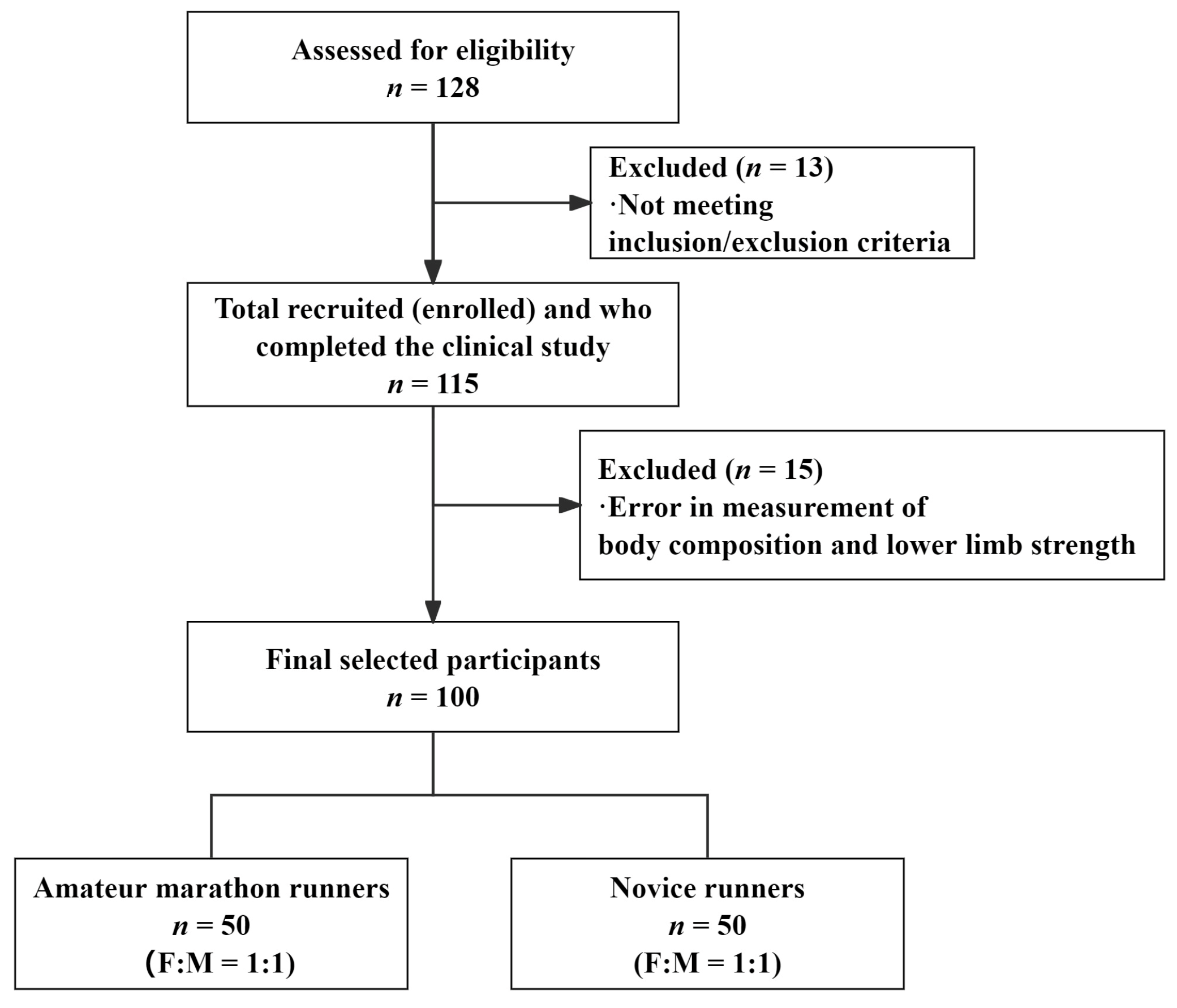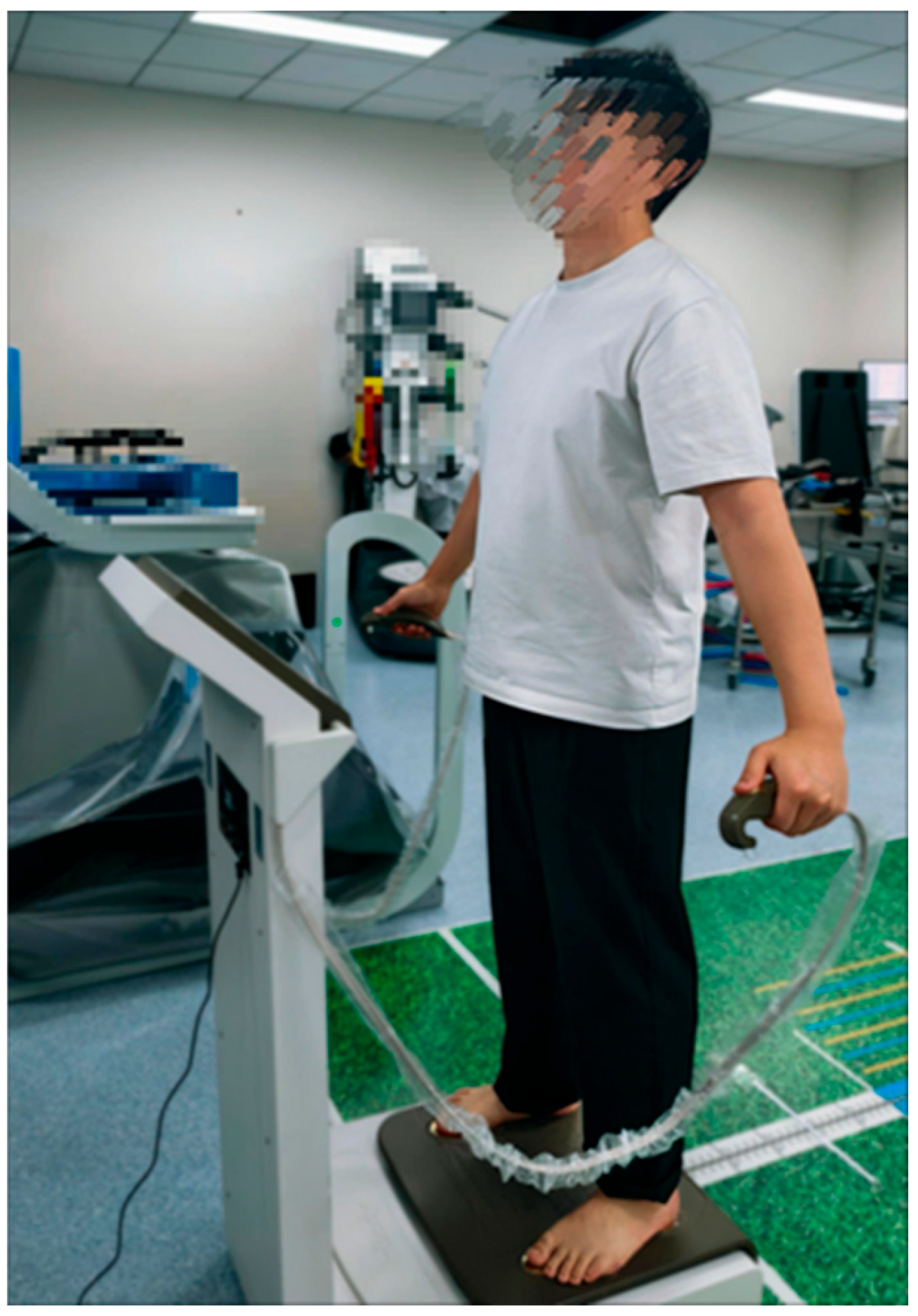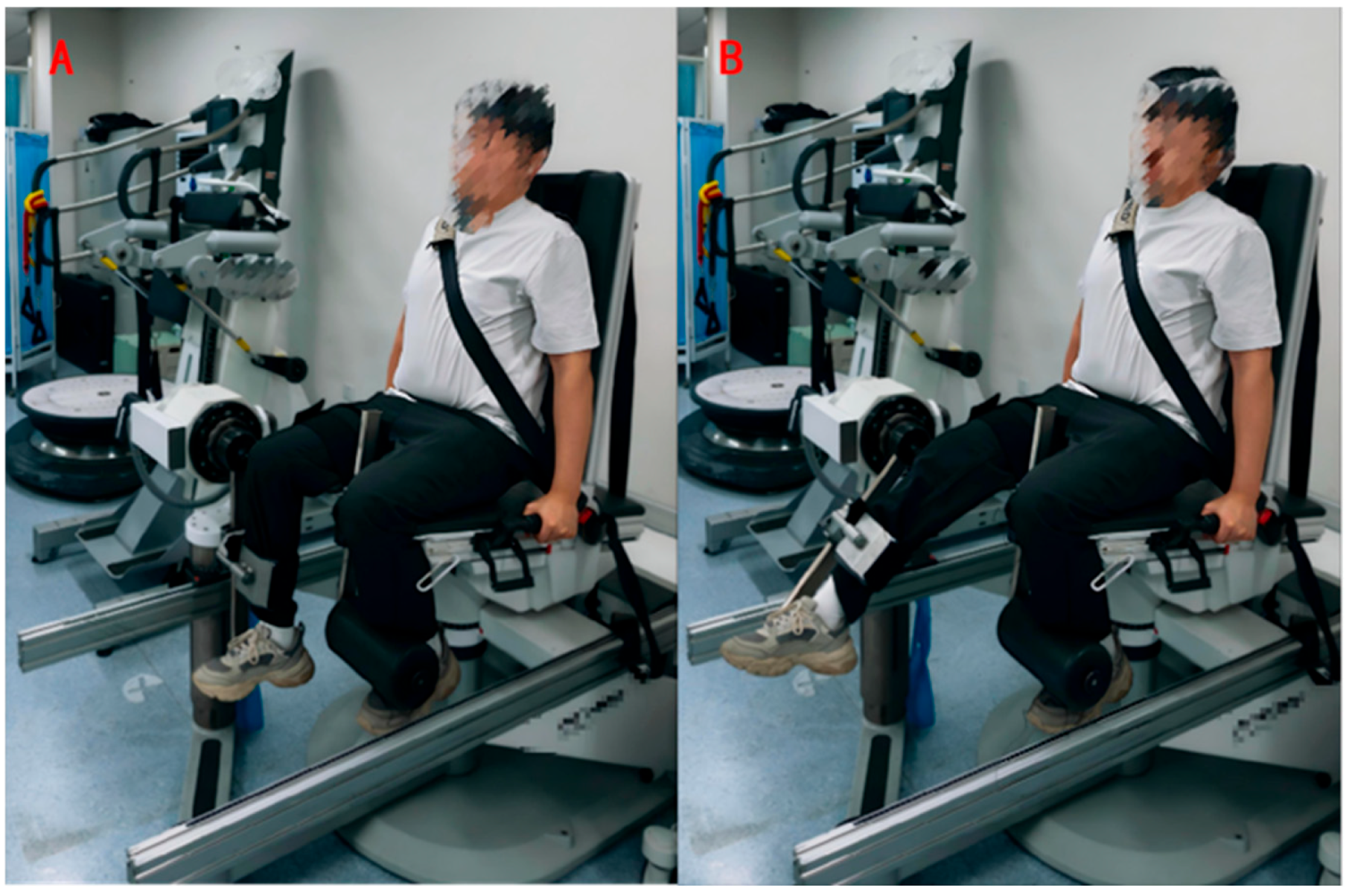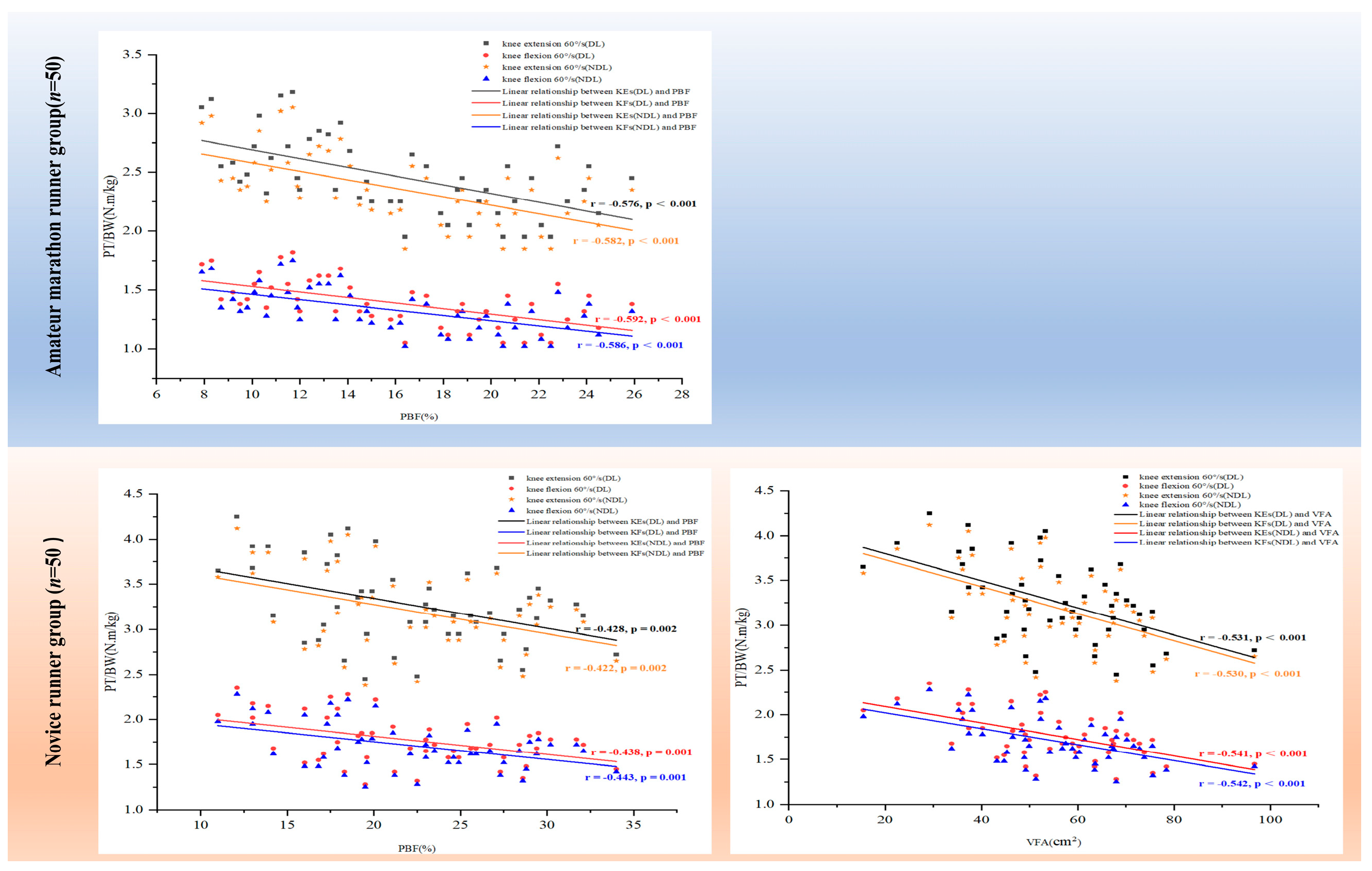Differences in Body Composition and Lower Limb Strength Between Novice and Amateur Marathon Runners: A Cross-Sectional Study
Abstract
1. Introduction
2. Materials and Methods
2.1. Study Design
2.2. Participants
2.3. Sample Size Calculation
2.4. Data Collection
2.4.1. Demographic and Body Composition Data
2.4.2. Lower Limb Muscle Strength Features
2.5. Statistical Analysis
3. Results
3.1. Demographic and Anthropometric Characteristics
3.2. Characterization of Body Composition in AMR and NR Groups
3.3. Characterization of Knee Muscle Strength in AMR and NR Groups
3.4. Correlation Between Knee Muscle Strength and Body Composition in AMR and NR Groups
4. Discussion
4.1. Strengths and Limitations
4.2. Practical Applications
5. Conclusions
Author Contributions
Funding
Institutional Review Board Statement
Informed Consent Statement
Data Availability Statement
Conflicts of Interest
Abbreviations
| AMR | Amateur marathon runner |
| NR | Novice runner |
| KEs | Knee extensors |
| KFs | Knee flexors |
| DL | Dominant leg |
| NDL | Non-dominant leg |
| SD | Standard deviation |
| FFM | Fat-free mass |
| SMM | Skeletal muscle mass |
| TBW | Total body water |
| PBF | Body fat percentage |
| VFA | Visceral fat area |
| BF | Body fat |
| BMI | Body mass index |
| H: Q | Hamstrings: Quadriceps ratio |
References
- Bredeweg, S.W.; Zijlstra, S.; Bessem, B.; Buist, I. The effectiveness of a preconditioning programme on preventing running-related injuries in novice runners: A randomised controlled trial. Br. J. Sports Med. 2012, 46, 865–870. [Google Scholar] [CrossRef] [PubMed]
- Chaudhari, A.M.W.; Van Horn, M.R.; Monfort, S.M.; Pan, X.; Oñate, J.A.; Best, T.M. Reducing Core Stability Influences Lower Extremity Biomechanics in Novice Runners. Med. Sci. Sports Exerc. 2020, 52, 1347–1353. [Google Scholar] [CrossRef] [PubMed]
- Shen, Y.; Yao, W.; Huang, Y.; Ye, L.; Liu, J.; Liu, M.; Ding, J.; Zhang, Y. MRI analysis of and factors related to knee injuries in amateur marathon runners. PLoS ONE 2024, 19, e0306257. [Google Scholar] [CrossRef] [PubMed]
- Brughelli, M.; Cronin, J.; Levin, G.; Chaouachi, A. Understanding change of direction ability in sport: A review of resistance training studies. Sports Med. 2008, 38, 1045–1063. [Google Scholar] [CrossRef]
- Vernillo, G.; Savoldelli, A.; Zignoli, A.; Skafidas, S.; Fornasiero, A.; La Torre, A.; Bortolan, L.; Pellegrini, B.; Schena, F. Energy cost and kinematics of level, uphill and downhill running: Fatigue-induced changes after a mountain ultramarathon. J. Sports Sci. 2015, 33, 1998–2005. [Google Scholar] [CrossRef]
- Herrmann, F.R.; Graf, C.; Karsegard, V.L.; Mareschal, J.; Achamrah, N.; Delsoglio, M.; Schindler, M.; Pichard, C.; Genton, L. Running performance in a timed city run and body composition: A cross-sectional study in more than 3000 runners. Nutrition 2019, 61, 1–7. [Google Scholar] [CrossRef]
- Chivate, D.; Chakkalathy, S.; Motimath, B. Correlation between dynamic balance, lower limb muscle power, and speed performance in sprinters: A cross-sectional study. Comp. Exerc. Physiol. 2024, 1, 81–89. [Google Scholar] [CrossRef]
- Stachoń, A.; Pietraszewska, J.; Burdukiewicz, A. Anthropometric profiles and body composition of male runners at different distances. Sci. Rep. 2023, 13, 18222. [Google Scholar] [CrossRef]
- Chen, G.; Gu, Z.; Wang, P.; Qi, Y.; Dai, J. Analysis of lower limb muscle strength characteristics of amateur runners with patellofemoral pain: A cross-sectional study. PLoS ONE 2024, 19, e0305141. [Google Scholar] [CrossRef]
- Jeukendrup, A.; Gleeson, M. Sport Nutrition: An Introduction to Energy Production and Performance; Human Kinetics: Champaign, IL, USA, 2004. [Google Scholar]
- Santos-Concejero, J.; Granados, C.; Irazusta, J.; Bidaurrazaga-Letona, I.; Zabala-Lili, J.; Tam, N.; Gil, S. Differences in ground contact time explain the less efficient running economy in North African runners. Biol. Sport 2013, 30, 181–187. [Google Scholar] [CrossRef]
- Moran, R.N.; Stewart, E.R.; Haller, M.; Ramirez, J. Leg Dominance Effects During Single- and Dual-Task Modified Balance Error Scoring System Assessment in Collegiate and High School Athletes. Orthop. J. Sports Med. 2025, 13, 23259671241301771. [Google Scholar] [CrossRef]
- Larsen, M.N.; Krustrup, P.; Araújo Póvoas, S.C.; Castagna, C. Accuracy and reliability of the InBody 270 multi-frequency body composition analyser in 10-12-year-old children. PLoS ONE 2021, 16, e0247362. [Google Scholar] [CrossRef] [PubMed]
- Lukaski, H.; Raymond-Pope, C.J. New Frontiers of Body Composition in Sport. Int. J. Sports Med. 2021, 42, 588–601. [Google Scholar] [CrossRef] [PubMed]
- McLester, C.N.; Nickerson, B.S.; Kliszczewicz, B.M.; McLester, J.R. Reliability and Agreement of Various InBody Body Composition Analyzers as Compared to Dual-Energy X-Ray Absorptiometry in Healthy Men and Women. J. Clin. Densitom. 2020, 23, 443–450. [Google Scholar] [CrossRef] [PubMed]
- Brewer, G.J.; Blue, M.N.M.; Hirsch, K.R.; Saylor, H.E.; Gould, L.M.; Nelson, A.G.; Smith-Ryan, A.E. Validation of InBody 770 bioelectrical impedance analysis compared to a four-compartment model criterion in young adults. Clin. Physiol. Funct. Imaging 2021, 41, 317–325. [Google Scholar] [CrossRef]
- van Tittelboom, V.; Alemdaroglu-Gürbüz, I.; Hanssen, B.; Heyrman, L.; Feys, H.; Desloovere, K.; Calders, P.; Van den Broeck, C. Reliability of Isokinetic Strength Assessments of Knee and Hip Using the Biodex System 4 Dynamometer and Associations with Functional Strength in Healthy Children. Front. Sports Act. Living 2022, 4, 817216. [Google Scholar] [CrossRef]
- Tuominen, J.; Leppänen, M.; Jarske, H.; Pasanen, K.; Vasankari, T.; Parkkari, J. Test-Retest Reliability of Isokinetic Ankle, Knee and Hip Strength in Physically Active Adults Using Biodex System 4 Pro. Methods Protoc. 2023, 6, 26. [Google Scholar] [CrossRef]
- González-Ravé, J.M.; Juárez, D.; Rubio-Arias, J.A.; Clemente-Suarez, V.J.; Martinez-Valencia, M.A.; Abian-Vicen, J. Isokinetic leg strength and power in elite handball players. J. Hum. Kinet. 2014, 41, 227–233. [Google Scholar] [CrossRef]
- Kukić, F.; Mrdaković, V.; Stanković, A.; Ilić, D. Effects of Knee Extension Joint Angle on Quadriceps Femoris Muscle Activation and Exerted Torque in Maximal Voluntary Isometric Contraction. Biology 2022, 11, 1490. [Google Scholar] [CrossRef]
- Naisheng, Z.; Lihua, H.; Ye, Z. Research on the Predictive Ability of Isokinetic Strength Testing for Knee Joint Extension of 1RM. ChineseGeneral Pract. 2024, 1–5. [Google Scholar] [CrossRef]
- Schindler, I.; Pontes, S.S.; Bertoni, M.B.M.; Junior, G.F.; Júnior, B.R.N.; de Jesus, F.L.A.; Neto, M.G. A Systematic Review of Isokinetic Muscle Strength in a Healthy Population With Special Reference to Age and Gender. Sports Health 2023, 15, 328–332. [Google Scholar] [CrossRef] [PubMed]
- Jenner, B.; Nottle, C.; Walters, J.L.; Saunders, S.W.; Leicht, A.S.; Crowther, R.G. Reliability of lower limb strength assessment in female team sport athletes. Phys. Ther. Sport. 2024, 68, 71–79. [Google Scholar] [CrossRef]
- Pinto, M.D.; Blazevich, A.J.; Andersen, L.L.; Mil-Homens, P.; Pinto, R.S. Hamstring-to-quadriceps fatigue ratio offers new and different muscle function information than the conventional non-fatigued ratio. Scand. J. Med. Sci. Sports 2018, 28, 282–293. [Google Scholar] [CrossRef] [PubMed]
- Obara, K.; Silva, P.; Silva, M.; Mendes, F.; Santiago, G.; Oliveira, I.; Cardoso, J. Isokinetic Training Program to Improve the Physical Function and Muscular Performance of an Individual with Partial Injury of the Medial Meniscus: A Case Report. Int. J. Sports Phys. Ther. 2023, 18, 758–768. [Google Scholar] [CrossRef]
- Bishop, C.; Read, P.; Lake, J.; Chavda, S.; Turner, A. Interlimb Asymmetries: Understanding How to Calculate Differences From Bilateral and Unilateral Tests. Strength. Cond. J. 2018, 40, 1–6. [Google Scholar] [CrossRef]
- Bishop, C.; Read, P.; Chavda, S.; Turner, A. Asymmetries of the Lower Limb: The Calculation Conundrum in Strength Training and Conditioning. Strength. Cond. J. 2016, 38, 27–32. [Google Scholar] [CrossRef]
- Henderson, A.R. Testing experimental data for univariate normality. Clin. Chim. Acta 2006, 366, 112–129. [Google Scholar] [CrossRef]
- Xu, Z.; Gao, F.; Fa, A.; Qu, W.; Zhang, Z. Statistical power analysis and sample size planning for moderated mediation models. Behav. Res. Methods 2024, 56, 6130–6149. [Google Scholar] [CrossRef]
- França, C.; Martins, F.; Lopes, H.; Marques, A.; de Maio Nascimento, M.; Przednowek, K.; Ihle, A.; Campos, P.; Gouveia, É.R. Knee muscle strength, body composition, and balance performance of youth soccer players. BMC Sports Sci. Med. Rehabil. 2024, 16, 206. [Google Scholar] [CrossRef]
- França, C.; Saldanha, C.; Martins, F.; de Maio Nascimento, M.; Marques, A.; Ihle, A.; Sarmento, H.; Campos, P.; Gouveia, É.R. Lower body strength and body composition in female football. Sci. Rep. 2025, 15, 9200. [Google Scholar] [CrossRef]
- Cataldi, D.; Bennett, J.P.; Quon, B.K.; Leong, L.; Kelly, T.L.; Binder, A.M.; Evans, W.J.; Prado, C.M.; Heymsfield, S.B.; Shepherd, J.A. Association of body composition measures to muscle strength using DXA, D(3)Cr, and BIA in collegiate athletes. Sci. Rep. 2025, 15, 5839. [Google Scholar] [CrossRef]
- Micheli, M.L.; Pagani, L.; Marella, M.; Gulisano, M.; Piccoli, A.; Angelini, F.; Burtscher, M.; Gatterer, H. Bioimpedance and impedance vector patterns as predictors of league level in male soccer players. Int. J. Sports Physiol. Perform. 2014, 9, 532–539. [Google Scholar] [CrossRef] [PubMed]
- Rosado, J.; Duarte, J.P.; Sousa, E.S.P.; Costa, D.C.; Martinho, D.V.; Valente-Dos-Santos, J.; Rama, L.M.; Tavares, Ó.M.; Conde, J.; Castanheira, J.; et al. Body composition among long distance runners. Rev. Assoc. Med. Bras. 2020, 66, 180–186. [Google Scholar] [CrossRef] [PubMed]
- Carrasco-Marginet, M.; Castizo-Olier, J.; Rodríguez-Zamora, L.; Iglesias, X.; Rodríguez, F.A.; Chaverri, D.; Brotons, D.; Irurtia, A. Bioelectrical impedance vector analysis (BIVA) for measuring the hydration status in young elite synchronized swimmers. PLoS ONE 2017, 12, e0178819. [Google Scholar] [CrossRef] [PubMed]
- Giorgi, A.; Vicini, M.; Pollastri, L.; Lombardi, E.; Magni, E.; Andreazzoli, A.; Orsini, M.; Bonifazi, M.; Lukaski, H.; Gatterer, H. Bioimpedance patterns and bioelectrical impedance vector analysis (BIVA) of road cyclists. J. Sports Sci. 2018, 36, 2608–2613. [Google Scholar] [CrossRef]
- Ekstrand, J.; Healy, J.C.; Waldén, M.; Lee, J.C.; English, B.; Hägglund, M. Hamstring muscle injuries in professional football: The correlation of MRI findings with return to play. Br. J. Sports Med. 2012, 46, 112–117. [Google Scholar] [CrossRef]
- Smarkusz-Zarzecka, J.; Ostrowska, L.; Leszczyńska, J.; Orywal, K.; Cwalina, U.; Pogodziński, D. Analysis of the Impact of a Multi-Strain Probiotic on Body Composition and Cardiorespiratory Fitness in Long-Distance Runners. Nutrients 2020, 12, 3758. [Google Scholar] [CrossRef]
- Nikolaidis, P.T.; Clemente-Suárez, V.J.; Chlíbková, D.; Knechtle, B. Training, Anthropometric, and Physiological Characteristics in Men Recreational Marathon Runners: The Role of Sport Experience. Front. Physiol. 2021, 12, 666201. [Google Scholar] [CrossRef]
- Clemente-Suarez, V.J.; Nikolaidis, P.T. Use of Bioimpedianciometer as Predictor of Mountain Marathon Performance. J. Med. Syst. 2017, 41, 73. [Google Scholar] [CrossRef]
- Kutac, P.; Bunc, V.; Buzga, M.; Krajcigr, M.; Sigmund, M. The effect of regular running on body weight and fat tissue of individuals aged 18 to 65. J. Physiol. Anthr. 2023, 42, 28. [Google Scholar] [CrossRef]
- Bourdon, P.C.; Cardinale, M.; Murray, A.; Gastin, P.; Kellmann, M.; Varley, M.C.; Gabbett, T.J.; Coutts, A.J.; Burgess, D.J.; Gregson, W. Monitoring athlete training loads: Consensus statement. Int. J. Sports Physiol. Perform. 2017, 12 (Suppl. S2), S2161–S2170. [Google Scholar] [CrossRef]
- Croisier, J.L.; Forthomme, B.; Namurois, M.H.; Vanderthommen, M.; Crielaard, J.M. Hamstring muscle strain recurrence and strength performance disorders. Am. J. Sports Med. 2002, 30, 199–203. [Google Scholar] [CrossRef]
- Aslan, Ö.; Batur, E.B.; Meray, J. The Importance of Functional Hamstring/Quadriceps Ratios in Knee Osteoarthritis. J. Sport. Rehabil. 2020, 29, 866–870. [Google Scholar] [CrossRef] [PubMed]
- Coombs, R.; Garbutt, G. Developments in the use of the hamstring/quadriceps ratio for the assessment of muscle balance. J. Sports Sci. Med. 2002, 1, 56–62. [Google Scholar] [PubMed]
- Andrade, M.S.; Silva, W.A.; de Lira, C.A.B.; Mascarin, N.C.; Vancini, R.L.; Nikolaidis, P.T.; Knechtle, B. Isokinetic Muscular Strength and Aerobic Physical Fitness in Recreational Long-Distance Runners: A Cross-Sectional Study. J. Strength. Cond. Res. 2022, 36, e73–e80. [Google Scholar] [CrossRef] [PubMed]
- Ueberschär, O.; Fleckenstein, D.; Warschun, F.; Walter, N.; Hoppe, M.W. Case report on lateral asymmetries in two junior elite long-distance runners during a high-altitude training camp. Sports Orthop. Traumatol. 2019, 35, 399–406. [Google Scholar] [CrossRef]
- França, C.; Gouveia, É.; Caldeira, R.; Marques, A.; Martins, J.; Lopes, H.; Henriques, R.; Ihle, A. Speed and Agility Predictors among Adolescent Male Football Players. Int. J. Environ. Res. Public Health 2022, 19, 2856. [Google Scholar] [CrossRef]
- Knechtle, B.; Knechtle, P.; Barandun, U.; Rosemann, T. Anthropometric and training variables related to half-marathon running performance in recreational female runners. Physician Sportsmed. 2011, 39, 158–166. [Google Scholar] [CrossRef]
- Kraemer, W. Fundamentals of resistance training: Progression and exercise prescription. Med. Sci. Sports Exerc. 2004, 36, 674–688. [Google Scholar] [CrossRef]




| AMR Group (n = 50) | NR Group (n = 50) | p | Cohen’s d | |
|---|---|---|---|---|
| Age (years) | 33.36 ± 5.55 | 33.84 ± 4.32 | 0.74 | 0.10 |
| Running experience (years) | 4.34 ± 2.00 *** | 0.54 ± 0.21 | <0.001 | 1.42 |
| Running volume (km/month) | 66.02 ± 12.75 *** | 19.48 ± 6.62 | <0.001 | 4.58 |
| Height (cm) | 171.32 ± 6.14 | 170.48 ± 8.51 | 0.69 | 0.11 |
| Weight (kg) | 64.51 ± 7.06 | 66.49 ± 11.35 | 0.46 | 0.21 |
| BMI (kg/m2) | 20.95 ± 1.77 | 21.75 ± 2.56 | 0.21 | 0.36 |
| Sex (male/female) | 25/25 | 25/25 | 1.00 | 0.00 |
| DL (right/left) | 40/10 | 45/5 | 0.169 | 0.14 |
| AMR Group (n = 50) | NR Group (n = 50) | p | Cohen’s d | |
|---|---|---|---|---|
| FFM (kg) | 49.97 ± 7.64 ** | 45.40 ± 8.41 | 0.005 | 0.57 |
| SMM (kg) | 28.06 ± 4.61 ** | 25.13 ± 5.07 | 0.003 | 0.60 |
| TBW (kg) | 36.94 ± 5.38 ** | 33.21 ± 5.95 | 0.001 | 0.66 |
| PBF (%) | 16.13 ± 5.07 *** | 22.17 ± 5.78 | <0.001 | 1.11 |
| VFA (cm2) | 37.17 ± 11.38 *** | 54.93 ± 15.65 | <0.001 | 1.30 |
| AMR Group (n = 50) | NR Group (n = 50) | PPT/BM | Cohen’s dPT/BM | PH:Q | Cohen’s dH:Q | ||||
|---|---|---|---|---|---|---|---|---|---|
| PT/BM (N.m/kg) | H:Q (%) | PT/BM (N.m/kg) | H:Q (%) | ||||||
| KEs | DL | 2.46 ± 0.32ab | 68.70 ± 12.08ab | 2.32 ± 0.33b | 55.60 ± 11.68 | 0.034 | 0.43 | <0.001 | 1.10 |
| NDL | 2.36 ± 0.31 | 60.60 ± 11.64a | 2.24 ± 0.31 | 55.80 ± 11.47 | 0.056 | 0.39 | 0.040 | 0.42 | |
| p | <0.001 | <0.001 | 0.008 | 0.848 | |||||
| Cohen’s d | 0.32 | 0.68 | 0.25 | 0.02 | |||||
| KFs | DL | 1.69 ± 0.20ab | 1.29 ± 0.20b | <0.001 | 2.00 | ||||
| NDL | 1.43 ± 0.20a | 1.25 ± 0.19 | <0.001 | 0.92 | |||||
| p | <0.001 | 0.027 | |||||||
| Cohen’s d | 1.30 | 0.21 | |||||||
Disclaimer/Publisher’s Note: The statements, opinions and data contained in all publications are solely those of the individual author(s) and contributor(s) and not of MDPI and/or the editor(s). MDPI and/or the editor(s) disclaim responsibility for any injury to people or property resulting from any ideas, methods, instructions or products referred to in the content. |
© 2025 by the authors. Licensee MDPI, Basel, Switzerland. This article is an open access article distributed under the terms and conditions of the Creative Commons Attribution (CC BY) license (https://creativecommons.org/licenses/by/4.0/).
Share and Cite
Shi, T.; Shi, Q.; Ren, S.; Huang, X.; Ren, J.; Gao, X.; Zhu, J. Differences in Body Composition and Lower Limb Strength Between Novice and Amateur Marathon Runners: A Cross-Sectional Study. Sports 2025, 13, 287. https://doi.org/10.3390/sports13090287
Shi T, Shi Q, Ren S, Huang X, Ren J, Gao X, Zhu J. Differences in Body Composition and Lower Limb Strength Between Novice and Amateur Marathon Runners: A Cross-Sectional Study. Sports. 2025; 13(9):287. https://doi.org/10.3390/sports13090287
Chicago/Turabian StyleShi, Tianxin, Qingzhao Shi, Shuang Ren, Xiaorui Huang, Jun Ren, Xin Gao, and Jingxian Zhu. 2025. "Differences in Body Composition and Lower Limb Strength Between Novice and Amateur Marathon Runners: A Cross-Sectional Study" Sports 13, no. 9: 287. https://doi.org/10.3390/sports13090287
APA StyleShi, T., Shi, Q., Ren, S., Huang, X., Ren, J., Gao, X., & Zhu, J. (2025). Differences in Body Composition and Lower Limb Strength Between Novice and Amateur Marathon Runners: A Cross-Sectional Study. Sports, 13(9), 287. https://doi.org/10.3390/sports13090287





